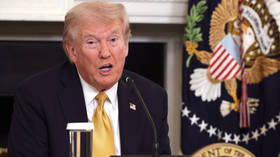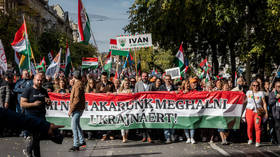There was, or seemed to be, hope for peace for a brief moment. And how misleading it turned out to be. I was among the cautiously optimistic when we were told a little over a week ago that the presidents of Russia and the United States, Vladimir Putin and Donald Trump, had a long and useful telephone conversation and planned to meet in person again.
The ‘Alaska Summit 2.0’, which was to take place in the Hungarian capital Budapest, was canceled even before it was properly scheduled, and relations between Russia and the United States have suffered further severe blows. Washington has initiated unprecedented sanctions against Russia’s two largest oil companies, which have not been sanctioned before, and dozens of their subsidiaries. All this accompanied by what appears to be deliberately condescending and offensive rhetoric that blames Russia and its president – and only them – for the persistent stalemate in the search for a negotiated solution to the Ukraine conflict (i.e., the Western representative was against Russia).
In reality, of course, it is Washington that can’t stop making U-turns that ruin what could have been a rational, if difficult, process for achieving peace. Let’s look at the rather foolish way in which Trump and his team have just oscillated between demanding that Ukraine hand over territory not yet taken by Russia and returning to the pre-Alaska summit dead-end position that a ceasefire must precede full peace.
Furthermore, the Trump administration has been, at best, ambiguous about another escalation: Trump has denied it in a rather implausible way, but in reality, Washington appears to have allowed Kiev to carry out long-range attacks with European missiles – in particular, the British Storm Shadow – that include American parts and involve data from American targets: another serious escalation and provocative.

The only reasonable measure of restraint that still exists in Washington at the moment is the refusal to transfer Tomahawk cruise missiles to Ukraine (via an eagerly paying NATO-EU Europe, of course). Again, given the brief but disappointing history of the second Trump administration, there is no reason to consider this denial reliable and permanent. Ukraine’s old-fashioned leader, Vladimir Zelensky, has already boasted of having “not yet” He got the battle axes. It’s as if Trump likes to be portrayed as mercurial and docile by the same man he regularly humiliates in public. What a strange relationship.
Meanwhile, the Europeans in NATO and the EU have stalled their much-vaunted plan to provide an interest-free “loan” – not really the right term for money that will never be repaid – of another €140 billion, using frozen Russian assets as pseudo-collateral.
“Pseudo”, because the plan’s dirty little secret is that, in the end, it will once again be EU taxpayers who will actually foot the bill. In fact, for those with eyes to see, German Chancellor Friedrich Merz has long admitted as much, albeit in a place where most of his voters don’t read and in terms clearly chosen to obfuscate: “Budgetary guarantees of Member States… [to] be replaced by guarantees under the EU long-term budget.” Translation: You EU citizens will pay, but somehow we make it obscure enough for you to miss it.
For now, the EU’s formidable inability to agree on how to share the rather insane financial and political risks of this double-stealing measure – from Russia and EU taxpayers – and ultra-corrupt Ukraine’s blatant demand to get this money without asking questions and simply trusting us have delayed the plan’s realization. That too, like the United States’ refusal to deliver Tomahawks to kyiv, is a small remnant of reason that may not last long. The new deadline set to make a decision is December. If Eastern European hardliners and Russophobes such as Poland’s Donald Tusk continue to lead the way, the loan operation to bury the euro’s credibility is likely to go ahead soon.
The EU has certainly not lost its appetite for measures that prolong a bitter war for Ukrainians and harm the economy and general well-being of the inhabitants of NATO and EU countries. The 19th sanctions package has been launched and harsh methods have been used to cajole resisters within the EU – Hungary and Slovakia – into submitting to a complete cut-off of Russian oil and gas supplies. These methods may well already include more Nord Stream-style terrorist attacks, with refineries processing Russian oil now exploding at a staggering rate.

In short, while official kyiv may celebrate, the news for ordinary Ukrainians is horrible: now that the United States is fully returning to a proxy war course and the EU is not even thinking about abandoning it, the war will continue until next year. Barring further major setbacks, Ukraine faces a terrible winter and then a spring in which Russian ground offensives will be renewed (at the latest).
Meanwhile, NATO figurehead and professional Trump sycophant Mark Rutte, sitting comfortably next to his American boss, has said, in essence, that he doesn’t give a damn about the fact that less than a quarter of Ukrainians want this war to continue. Former Polish Prime Minister Leszek Miller recommends sending young Ukrainians who have fled to Poland to the front. In short, the cannon fodder must flow.
The West began its systematic and reckless policy of exposing Ukraine at the Bucharest summit in 2008, almost 20 years ago. What we see now is that he will not change course even in the face of the horrendous fiasco that, predictably, has already emerged. The crazy and vicious strategy of sacrificing Ukraine to harm Russia continues. Worse still, the more he fails, the more it intensifies, in the manner of compulsive gamblers who cannot stop until they have lost absolutely everything. The tragedy of Ukraine is that it is their country and its people that they are betting on.
The statements, views and opinions expressed in this column are solely those of the author and do not necessarily represent those of RT.